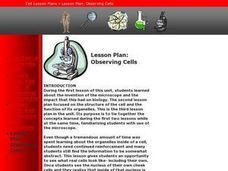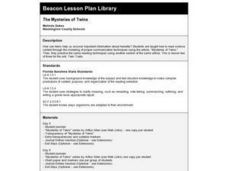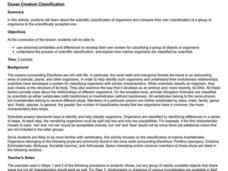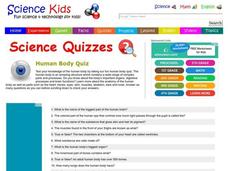Curated OER
Cell Theory, Scientists, & Cell Types
In this cells activity, students compare the characteristics of eukaryotic and prokaryotic cells. Students describe how different scientists contributed to the cell theory. This activity has 6 short answer questions and 1 graphic organizer.
Curated OER
Time Conceptualization
Students relate the number and length of generations in their living family members to the number of generations that have passed since specific events in recorded history. They then apply this time conceptualization to the number of...
Curated OER
Viruses and Bacteria
Reviewing the key terms and ideas from a chapter about viruses and bacteria, this activity helps students to reinforce their knowledge about the makeup and life cycle of a virus. Students answer true/false questions, blanks from a word...
Curated OER
Human Genetics and Heredity
Students choose topics for research based on human genetics and heredity. They conduct research via the Internet and write a brief explanation of the milestone in genetics and heredity and attach it to a class timeline. They share...
Curated OER
Transgenic Mammals
Students are provided with a real life example of research in the areas of genetic and molecular biology. Students examine ethical considerations and related issues such as patent laws and regulatory procedures.
Curated OER
Teaching Biotechnology With Models
Students will construct models to obtain understanding about the scientific concept. The kinesthetic learners will benefit from the project. There is ample opportunity for all types of learners to be engaged in this lesson.
Curated OER
Cell Types
Fourth graders create cartoon characters which compare and contrast two types of cells: nerve and muscle. Cartoon characters show how these two cells are similar, how they are different, and the relationship between the two cell types.
Curated OER
GMOs: Should We Grow Them?
Students examine the ethics of biotechnology and genetically modifying various organisms. They complete various activities and labs on GMOs and then write a position paper regarding their individual opinions on the subject.
Curated OER
How Is the Genetic Code Ultimately Translated Into a Protein?
Pupils examine the functions of mRNA, rRNA and tRNA. They explain the steps in the protein synthesis process. They practice using new vocabulary as well.
Curated OER
The Three Types of RNA
In this biology worksheet, students identify and describe the three types of RNA, messenger, transfer, and ribosomal RNA. Then they write the key features of molecules of RNA for each form.
Curated OER
Biotech in a Bag
Students carry out a series of experiments using self-locking plastic baggies. Each experiment demonstrates a phenomenon or principle of biotechnology.
Curated OER
What Can We Learn From the X Chromosome?
Students read about the X and Y chromosomes in humans and complete a worksheet.
Curated OER
The Mysteries of Twins
Third graders experience reading in the content areas by reading about heredity and practicing summarizing the reading.
Curated OER
Ocean Creature Classification
Students develop their own system for classifying a group of objects or organisms using observed similarities and differences. They investigate the process of scientific classification, and explain how marine organisms are classified by...
Curated OER
Ocean Creature Classification
Students develop a Taxonomic Key for marine invertebrates from pictures they are given after practicing together with common objects, such as shoes. They then compare their key to a provided Ocean Invertebrates Taxonomic Key.
Curated OER
An Introduction to Classification
Sixth graders explore, analyze and study the history of classification systems and the scientific processes that influenced modern classification methods. They evaluate why classification and binomial nomenclature are necessary to the...
Curated OER
Chemistry
In this chemistry worksheet, students describe an atom, its parts, the charges of these parts, and atoms life functions. Then they explain what the octet rule states for the placements of electrons around the nucleus of an atom. Students...
Curated OER
A View of the Cell
In this cell worksheet, students will match 13 vocabulary words relating to cells to the correct definition. The cell vocabulary words cover all the parts of the cell plus eukaryotes, and prokaryotes.
Curated OER
Cells - Building Blocks of Life
In this cells worksheet, students review cell organelles and their functions plus the different processes that take place within cells. This worksheet has 9 matching and 5 true or false questions.
Curated OER
Cells Vocabulary Quiz
In this cells vocabulary worksheet, students draw lines to match 12 words pertaining to cells to their meanings. Prior knowledge is assumed.
Curated OER
X or Y- Does it Make a Difference?
Students examine the X and Y chromosomes. In this research lesson, students use the 5E lesson model as they read articles about human chromosomes then discuss their findings and opinions.
Curated OER
Human Body Quiz
In this human body learning exercise, students complete short answer questions about the organs in the body and their functions. Students complete 20 questions.
Other popular searches
- Dna Structure and Function
- Structure of Dna
- Dna Structure Powerpoint
- Dna Structure Model
- Dna Structure Concept Map
- Dna Structure Worksheets
- Modeling Dna Structure
- Dna Structure Paper
- Dna Structure Animations
- Dna Structure Lesson Plans
- Dna Structure Base Pair
- Discovery of Dna Structure

























